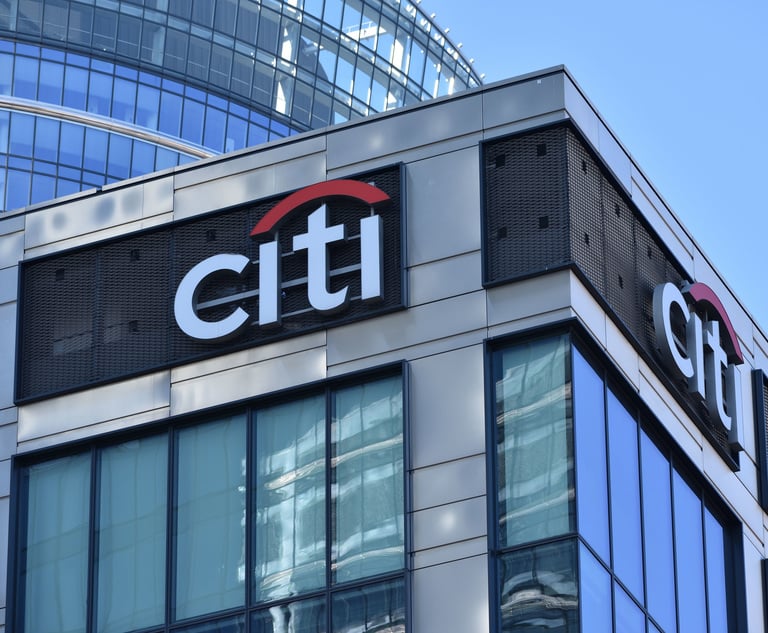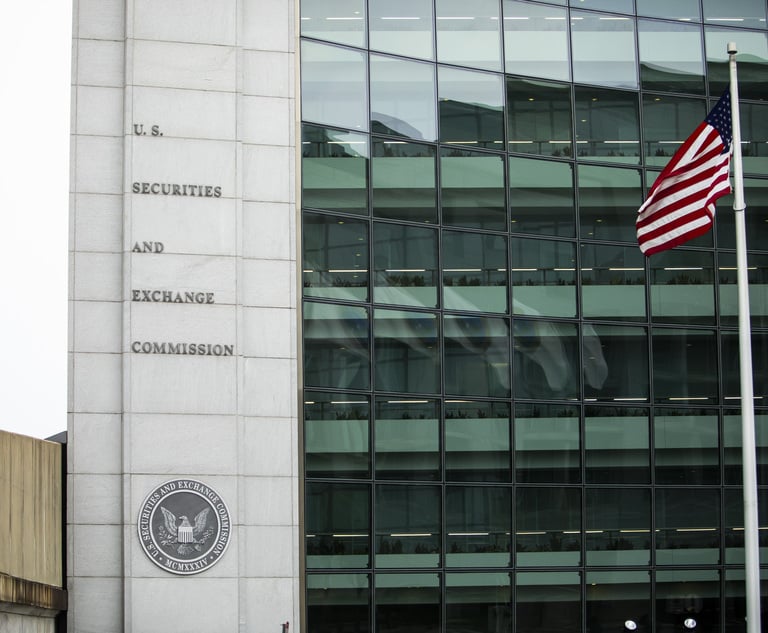As NYC Council Sets Vote on Regulating Ridehails, Lawyers Eye Options to Fight Back
If the City Council approves new regulations on Uber and other ride-hailing services, including a cap on the size of their fleets, the industry may have a few legal options at its disposal to fight back.
August 03, 2018 at 04:52 PM
4 minute read
 The New York City Council is set to vote Wednesday on a package of bills to impose new regulations on Uber and other ride-hailing services, including a first-of-its-kind freeze on the number of cars the companies can have on the city's streets that has been met with stiff opposition from the industry. Uber, Lyft and other services have become an increasingly popular way to get around New York City as the performance of public transit has flagged in recent years and left commuters fed up. Ride-hailing services have been identified as a contributing factor in increased congestion on New York City's streets and also played a role in the falling value of taxi medallions, which had been valued at more than $1 million in 2013 and have since fallen to $250,000 or less. Also on the minds of lawmakers is a recent rash of cab driver suicides, apparently tied to the falling value of the medallion. City Council Speaker Corey Johnson supports the measures and has said publicly that he is confident that proposals, which includes a minimum wage for drivers, will get through the council. His office confirmed on Friday that the bills are moving toward a vote. In a last-ditch effort before the deadline to amend the bills, Uber, Lyft and a smaller competitor, Via, proposed to form a $100 million hardship fund to help with the nose-diving value of taxi medallions if the council agreed to scrap the cap, but city leaders turned down the offer. In its fight with the city over the proposed new regulations, the industry—deemed “for-hire vehicle” services or “transportation networks” in the parlance of government—has argued that regulations would not only negatively affect service across the city, particularly outside of Manhattan, but disproportionately affect communities of color, where many have had to endure being passed up by taxis. “We're filling in the gaps, but capping Uber is a mistake because it's going to leave New Yorkers stranded,” said Uber spokeswoman Danielle Filson. With respect to other proposals before the council, Filson said that Uber does not oppose minimum pay for drivers. In a statement, Lyft argues that the industry's “churn rate” is 25 percent and thus a freeze would cause across-the-board reductions in service. “This would take New York back to an era of standing on the corner and hoping to get a ride. Wait times would increase significantly and driver earnings and job opportunities would shrink,” the statement reads. “Worst of all, the proposals prioritize corporate medallion owners above the overwhelming majority of New Yorkers.” The Tri-State Transportation Campaign, a nonprofit that supports decreased reliance on motorized transportation, conducted a study finding that app-based services are doing the “yeoman's work” in terms of serving the outer boroughs. People in lower-income neighborhoods have a higher likelihood of catching a ride with an app-based service or a green “borough cab” than they have with a yellow cab, according to the study. As for the issue of service refusal by cabbies as well as for-hire vehicles and ride-hailing services, the city announced this past week that it would form a new “Office of Inclusion” within the TLC to prosecute refusal claims. According to data from the TLC, complaints against for-hire vehicles are on the rise, while complaints against cabs have fallen. In 2017, there were 343 complaints about service refusal by for-hire vehicles, up from 175; in the same time frame, complaints against cabs fell from 4,684 to 1,834.
The New York City Council is set to vote Wednesday on a package of bills to impose new regulations on Uber and other ride-hailing services, including a first-of-its-kind freeze on the number of cars the companies can have on the city's streets that has been met with stiff opposition from the industry. Uber, Lyft and other services have become an increasingly popular way to get around New York City as the performance of public transit has flagged in recent years and left commuters fed up. Ride-hailing services have been identified as a contributing factor in increased congestion on New York City's streets and also played a role in the falling value of taxi medallions, which had been valued at more than $1 million in 2013 and have since fallen to $250,000 or less. Also on the minds of lawmakers is a recent rash of cab driver suicides, apparently tied to the falling value of the medallion. City Council Speaker Corey Johnson supports the measures and has said publicly that he is confident that proposals, which includes a minimum wage for drivers, will get through the council. His office confirmed on Friday that the bills are moving toward a vote. In a last-ditch effort before the deadline to amend the bills, Uber, Lyft and a smaller competitor, Via, proposed to form a $100 million hardship fund to help with the nose-diving value of taxi medallions if the council agreed to scrap the cap, but city leaders turned down the offer. In its fight with the city over the proposed new regulations, the industry—deemed “for-hire vehicle” services or “transportation networks” in the parlance of government—has argued that regulations would not only negatively affect service across the city, particularly outside of Manhattan, but disproportionately affect communities of color, where many have had to endure being passed up by taxis. “We're filling in the gaps, but capping Uber is a mistake because it's going to leave New Yorkers stranded,” said Uber spokeswoman Danielle Filson. With respect to other proposals before the council, Filson said that Uber does not oppose minimum pay for drivers. In a statement, Lyft argues that the industry's “churn rate” is 25 percent and thus a freeze would cause across-the-board reductions in service. “This would take New York back to an era of standing on the corner and hoping to get a ride. Wait times would increase significantly and driver earnings and job opportunities would shrink,” the statement reads. “Worst of all, the proposals prioritize corporate medallion owners above the overwhelming majority of New Yorkers.” The Tri-State Transportation Campaign, a nonprofit that supports decreased reliance on motorized transportation, conducted a study finding that app-based services are doing the “yeoman's work” in terms of serving the outer boroughs. People in lower-income neighborhoods have a higher likelihood of catching a ride with an app-based service or a green “borough cab” than they have with a yellow cab, according to the study. As for the issue of service refusal by cabbies as well as for-hire vehicles and ride-hailing services, the city announced this past week that it would form a new “Office of Inclusion” within the TLC to prosecute refusal claims. According to data from the TLC, complaints against for-hire vehicles are on the rise, while complaints against cabs have fallen. In 2017, there were 343 complaints about service refusal by for-hire vehicles, up from 175; in the same time frame, complaints against cabs fell from 4,684 to 1,834.This content has been archived. It is available through our partners, LexisNexis® and Bloomberg Law.
To view this content, please continue to their sites.
Not a Lexis Subscriber?
Subscribe Now
Not a Bloomberg Law Subscriber?
Subscribe Now
NOT FOR REPRINT
© 2025 ALM Global, LLC, All Rights Reserved. Request academic re-use from www.copyright.com. All other uses, submit a request to [email protected]. For more information visit Asset & Logo Licensing.
You Might Like
View All
New York-Based Skadden Team Joins White & Case Group in Mexico City for Citigroup Demerger

Bankruptcy Judge Clears Path for Recovery in High-Profile Crypto Failure
3 minute read
US Judge Dismisses Lawsuit Brought Under NYC Gender Violence Law, Ruling Claims Barred Under State Measure
Trending Stories
Who Got The Work
J. Brugh Lower of Gibbons has entered an appearance for industrial equipment supplier Devco Corporation in a pending trademark infringement lawsuit. The suit, accusing the defendant of selling knock-off Graco products, was filed Dec. 18 in New Jersey District Court by Rivkin Radler on behalf of Graco Inc. and Graco Minnesota. The case, assigned to U.S. District Judge Zahid N. Quraishi, is 3:24-cv-11294, Graco Inc. et al v. Devco Corporation.
Who Got The Work
Rebecca Maller-Stein and Kent A. Yalowitz of Arnold & Porter Kaye Scholer have entered their appearances for Hanaco Venture Capital and its executives, Lior Prosor and David Frankel, in a pending securities lawsuit. The action, filed on Dec. 24 in New York Southern District Court by Zell, Aron & Co. on behalf of Goldeneye Advisors, accuses the defendants of negligently and fraudulently managing the plaintiff's $1 million investment. The case, assigned to U.S. District Judge Vernon S. Broderick, is 1:24-cv-09918, Goldeneye Advisors, LLC v. Hanaco Venture Capital, Ltd. et al.
Who Got The Work
Attorneys from A&O Shearman has stepped in as defense counsel for Toronto-Dominion Bank and other defendants in a pending securities class action. The suit, filed Dec. 11 in New York Southern District Court by Bleichmar Fonti & Auld, accuses the defendants of concealing the bank's 'pervasive' deficiencies in regards to its compliance with the Bank Secrecy Act and the quality of its anti-money laundering controls. The case, assigned to U.S. District Judge Arun Subramanian, is 1:24-cv-09445, Gonzalez v. The Toronto-Dominion Bank et al.
Who Got The Work
Crown Castle International, a Pennsylvania company providing shared communications infrastructure, has turned to Luke D. Wolf of Gordon Rees Scully Mansukhani to fend off a pending breach-of-contract lawsuit. The court action, filed Nov. 25 in Michigan Eastern District Court by Hooper Hathaway PC on behalf of The Town Residences LLC, accuses Crown Castle of failing to transfer approximately $30,000 in utility payments from T-Mobile in breach of a roof-top lease and assignment agreement. The case, assigned to U.S. District Judge Susan K. Declercq, is 2:24-cv-13131, The Town Residences LLC v. T-Mobile US, Inc. et al.
Who Got The Work
Wilfred P. Coronato and Daniel M. Schwartz of McCarter & English have stepped in as defense counsel to Electrolux Home Products Inc. in a pending product liability lawsuit. The court action, filed Nov. 26 in New York Eastern District Court by Poulos Lopiccolo PC and Nagel Rice LLP on behalf of David Stern, alleges that the defendant's refrigerators’ drawers and shelving repeatedly break and fall apart within months after purchase. The case, assigned to U.S. District Judge Joan M. Azrack, is 2:24-cv-08204, Stern v. Electrolux Home Products, Inc.
Featured Firms
Law Offices of Gary Martin Hays & Associates, P.C.
(470) 294-1674
Law Offices of Mark E. Salomone
(857) 444-6468
Smith & Hassler
(713) 739-1250







